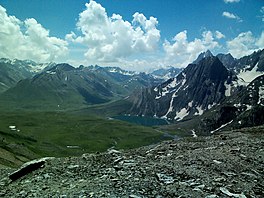| Great Lakes Trek | |
|---|---|
 Twin lakes of Vishansar and Krishansar seen from Gadsar Pass. Twin lakes of Vishansar and Krishansar seen from Gadsar Pass. | |
| Length | Approx. 42 miles (68 km) |
| Location | Central Kashmir Valley |
| Designation | Kashmir Great Lakes Trek |
| Trailheads | East: Sonamarg West: Naranag |
| Use | Hiking |
| Highest point | Gadsar Pass, 13,750 ft (4,190 m) |
| Lowest point | Naranag, 6,982 ft (2,128 m) |
| Difficulty | Moderate |
| Season | June to September |
| Sights | Vishansar Lake, Krishansar Lake, Gadsar Lake, Satsar Lakes, Gangabal Lake, Nundkol Lake |
| Hazards | Cold nights Warm sunny days Occasional rainfall |

The Great Lakes Trek or Kashmir Great Lakes Trek commercially known as Sonamarg-Vishansar-Naranag Trek is an alpine himalayan high-altitude trek in the Kashmir Valley in the Indian state of Jammu and Kashmir. This is the most famous trek in Kashmir. The trek is usually completed in 6-7 days and is rated as moderate-difficult in terms of terrain and trail difficulty. The trek is an absolute treat and worth every effort as one gets to see new alpine lakes, mountain peaks, passes, meadows and glaciers almost every subsequent day.
Itinerary
The trek can be started from both, Sonamarg and Naranag but is generally considered to be easier if started from Sonamarg. If started from sonmargh, one does a base camp at a place called table top or 'Shaukdari'. Its a 6-7 hours trek from the point where the car leaves you and a good spot for a base camp as its inhabited by the local Gujjar-Bakarwal population and there is plenty of firewood available.
The second day is a long trek to the twin lakes of Vishansar-Kishansar via the Nichnai pass. There is a possibility of finding mobile network reception at the pass on bsnl network.
References
- ^ "Great Lakes Trek". Kashmir Treks. Retrieved 16 October 2018.
- "Kashmir Great Lakes Trek". IndianExpress.com. Retrieved 11 October 2018.
- "Kashmir Great Lakes Trek - Trek the Indian Himalayas". Indiahikes. Retrieved 31 July 2021.
This article related to a location in Jammu and Kashmir is a stub. You can help Misplaced Pages by expanding it. |